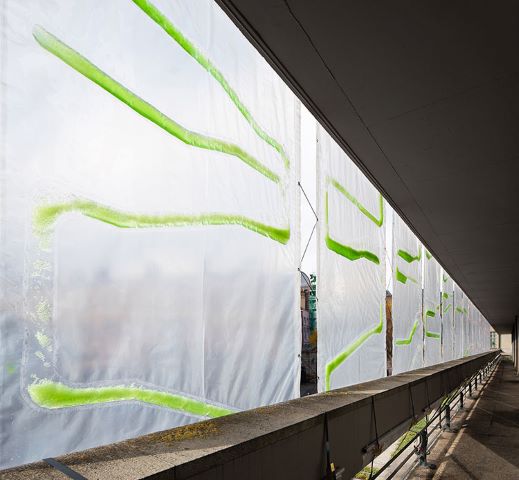

Curtains that could clean Air
Conceived as an “urban curtain”, Photo.Synth.Etica captures CO2 from the atmosphere and stores it in real-time: approximately one kilo of CO2 per day, equivalent to that of 20 large trees. Each module functions as a photobioreactor, a digitally designed and custom made bioplastic container that utilizes daylight to feed the living micro-algal cultures and releases luminescent shades at night.
Unfiltered urban air is introduced at the bottom of the Photo.Synth.Etica façade and, while air bubbles naturally rise through the watery medium within the bioplastic photobioreactors, they come into contact with voracious microbes.
The carbon-neutral bio-curtain uses microalgae to capture carbon dioxide from polluted air and produce oxygen. “It is a new kind of urban symbiosis,” says co-founder Claudia Pasquero. CO2 molecules and air pollutants are captured and stored by the algae, and grow into biomass. This can be harvested and employed in the production of bioplastic raw material that constitutes the main building material of the photobioreactors. The cyanobacteria cells in the living cultures consume the toxic particles so that the air is cleaned as it rises, while also sequestering the carbon and producing oxygen, which is released at the top. “The curtain interacts with the air of the environment in which it is embedded,” Pasquero explains. “It acts as a medium that allows the air to flow through and trade CO2 with the microalgae before escaping the system.”


To culminate the process, freshly photosynthesized oxygen is released at the top of each façade unit of Photo.Synth.Etica, and out into the urban microclimate.
The curtain is designed to be hung from the side of a building. It is composed of 16 modules, each 2m x 7m, and made from two layers of transparent bioplastic, which are welded together to create pockets of microalgae suspended in a biogel medium.
Thanks to robotic and digital fabrication methods, the algal density of the bio-curtain’s pockets can be altered across the facade, depending on an environment’s C02 level and the amount of shading required.
[related_post]
The designers envisage the curtain being applied to new buildings, but it can also be retrofitted to existing facades. As the curtain is lightweight and does not require heavy substructures when installed, it could be used to sustainably renovate the 80s style office blocks, for example. “A more affordable version is in development that will target the large distribution and warehouse market,” says Pasquero. “The aim is to cover the large surfaces of malls, distribution hubs, data centers and other large ‘shed’ typologies.”
Depending on the complexity of the system and the material used, the bio curtain costs around €300 (Rs 23,000) to €2,000 (Rs 1.5 L) per square meter. The organic biomass that the microalgae produce as a waste product can be harvested for use in bioplastics or sustainable textiles such as microbial cellulose.
In a significant move toward advancing green energy and industrial growth in the state, Himachal…
Golabl chemical conglomerate BASF has announced that its now offering the world’s first biomass-balanced polyethersulfone…
In a crucial stint to bolster the biogas sector and sustainable dairying in the country,…
TotalEnergies SE has received approval to proceed with its Middlebrook solar and battery project in…
Andhra Pradesh Chief Minister Chandrababu Naidu has inaugurated the Rs 1,000-crore green hydrogen plant of…
The BITS Pilani has developed an innovative solution for managing landfill leachate, domestic septage, and…
View Comments
Its an excellent work. I want to do some expriments in tjis field.